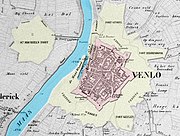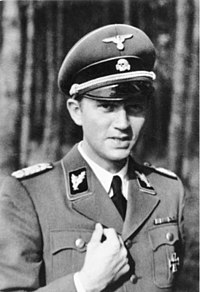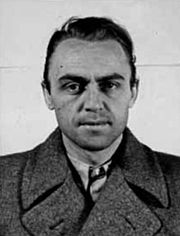The Venlo Incident was a covert German Sicherheitsdienst (SD-Security Service) engineered capture of two British SIS (Secret Intelligence Service) agents on 9 November 1939.
The incident was used by the presiding National Socialist German Workers' Party government (for propaganda purposes) to link the United Kingdom to Georg Elser's failed assassination (time-bomb) attempt on German Chancellor Adolf Hitler at the Bürgerbräukeller in Munich (Germany) on 8 November 1939 and to justify Germany's later invasion of the Netherlands, a neutral country, on 10 May 1940.
History[]

Historic Venlo on the River Meuse

Walter Schellenberg as an SS-Oberführer
Two assigned British SIS agents had met supposed discontented German Army officers in the Dutch border town of Venlo. Following a series of covert meetings, these German Army officers communicated that they were plotting a coup d'état against Chancellor Adolf Hitler. The initial meeting had been arranged with the British SIS in early September 1939 by a known German political refugee named Dr. Franz Fischer, who was exiled in the Netherlands, but who unbeknown to the British SIS, was working covertly for the Gestapo and then Sturmbannführer (Major) Walter Schellenberg[1] of the Foreign Intelligence (Counter-Espionage) section of the Sicherheitsdienst (SD). This political refugee's primary task was to collect and feed false information to the British SIS in general, as part of the German Sicherheitsdienst network of intelligence operations.

Cafe Backus, in the distance the German border
The British SIS had assigned two agents to the case, Captain Sigismund Payne Best (an experienced British Army intelligence officer and well connected businessman in the Netherlands, who at the time was residing in The Hague together with his Dutch wife) and Major Richard Henry Stevens (a less-experienced intelligence operative working covertly for the British SIS as a passport control officer in The Hague, Netherlands). In the Netherlands, they met these discontented German Army officers, including Major Walter Schellenberg, who was masquerading as a "Hauptmann (Captain) Schämmel". Schellenberg, as "Hauptmann Schämmel" claimed that the German High Command was concerned about high losses suffered during the invasion of Poland and intended to have Chancellor Adolf Hitler deposed from power.
Capture of British agents[]

Alfred Naujocks
Reichsführer-SS Heinrich Himmler, who along with Hitler had only just escaped death in the failed Bürgerbräukeller assassination attempt, seized the opportunity: in an angry telephone conversation he ordered the so-called "Hauptmann Schämmel" to capture the two British SIS agents for interrogation about British involvement into the Bürgerbräukeller assassination attempt. On the night of 8–9 November 1939, German SS-Sonderkommandos (SS Special Units) under the operations command of SD man Alfred Naujocks, crossed into the Netherlands at Venlo. They were to meet with the two British SIS agents in a café, Café Backus, situated just metres behind the German-Dutch border crossing post on the Netherlands side. To reinforce credibility, the British SIS agents had been promised that they were to meet a German Army General, who was leading the intended coup d'état, and agents Best and Stevens took with them Dutch intelligence officer Lieutenant Dirk Klop.
When Best and the others arrived, the awaiting German agents surrounded their car with machine guns and opened fire, mortally wounding Klop and forcibly dragging the two British agents and the dying Klop over the border into Germany.
The Germans blamed the near-simultaneous assassination attempt on Hitler in Munich on British agents such as Stevens and Best.[2] Under interrogation in Berlin, the two captured British SIS agents revealed much to the Gestapo, though the extent of useful information pried out of them remains uncertain. In Britain, the capture of these two significant agents had destroyed much of their network operating in the Netherlands, and left London feeling uncertain to the extent of knowledge that had been gained by the German Security Services, fearing their entire espionage network throughout Western Europe may be incapacitated.
This incident also subsequently made the British very suspicious of any further approach from any kind of professed German anti-Hitler resistance. Hitler used it as an excuse to claim that The Netherlands was involved with Britain and had violated its own neutrality.
Best and Stevens remained imprisoned until the end of the war.
The Venlo Incident was described in episode 1 of BBC Radio 4's "MI6: A Century in the Shadows", broadcast on Monday, 27 July 2009.
Payne Best recalled: "I know I was standing next to Stevens when four of these men jumped off and rushed towards us. Stevens said 'Our number's up.' Last I heard of him for five-and-a-half years. Then the next moment there were two fellows in front of each of us, one holding a pistol to our heads and the other putting handcuffs on. Then the Germans shouted at us 'March!', and prodding us in the back with their pistols and calling 'Hup! Hup! Hup!', they rushed us along toward the German frontier."
Fictional portrayals[]
The Venlo Incident is the inspiration for the ending of the first episode in the BBC comedy-drama Private Schulz. It was also used by William Boyd in his 2006 book, Restless. Venlo and Klop are renamed, respectively, Prenslo and Lt. Joos. The two SIS officers are not named. Café Backus is named.
Bibliography[]
- S. Payne Best, The Venlo Incident (1950)
- Reinhard R. Doerries, Hitler's Last Chief of Foreign Intelligence: Allied interrogations of Walter Schellenberg, London, (2003), ISBN 0-7146-5400-0.
- Documentary - Hitler's Bodyguard: Bombs and Paranoia (2008, Episode 7/13), (Convinced that a failed bomb plot had roots in England, a Gestapo counterintelligence officer engineered an elaborate sting to snatch British agents.). The Military Channel's documentary series.
References[]
- ↑ "Affidavit of Walter Schellenburg". Nazi Conspiracy and Aggression. Volume VII. USGPO, Washington, 1946/pp.622-629. Document UK-81. Washington. 1946. http://ess.uwe.ac.uk/genocide/schellenberg.htm. Retrieved 06. October 2010.
- ↑ Knickerbocker, H.R. (1941). Is Tomorrow Hitler's? 200 Questions On the Battle of Mankind. Reynal & Hitchcock. pp. 67. http://books.google.com/books?id=RwGwpIBHhgcC&lpg=PR2&pg=PA67#v=onepage&q&f=false.
Coordinates: 51°22′54.74″N 6°13′1.21″E / 51.3818722°N 6.2170028°E
The original article can be found at Venlo Incident and the edit history here.